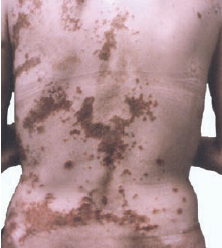Necrolytic migratory erythema and pancreatic glucagonoma
Abstract
Necrolytic migratory erythema is a rare paraneoplastic dermatosis that may be the first clinical manifestation of the glucagonoma syndrome, a disorder characterized by mucocutaneous rash, glucose intolerance, hypoaminoacidemia, hyperglucagonaemia and pancreatic glucagonoma. The clinical case of a 45-year-old woman is presented. She had been experiencing weight loss, polydipsia, polyphagia, postprandial emesis, excessive hair loss and abdominal pain for two months. Erythematous, scaly and migratory plaques with 20 days of evolution were found on her trunk, perineum, elbows, hands, feet, inframammary and antecubital folds. The skin biopsy revealed noticeable vacuolar changes in high epidermal cells, extensive necrosis and thin orthokeratotic cornified layer. These findings pointed to a diagnosis of necrolytic migratory erythema. A suggestion was made to investigate a pancreatic glucagonoma. Laboratory tests showed moderate anemia, hyperglycemia and marked hyperglucagonaemia. Abdominal ultrasound revealed a mass in the tail of the pancreas measuring 6 x 5 x 5 cm which was resected. The histopathological findings were compatible with a diagnosis of glucagonoma, as confirmed by immunohistochemistry. Skin symptoms disappeared 10 days after the tumor resection. We can conclude that the histological changes defined may be clues that can lead the search for a distant skin disease and allow for its diagnosis. The histological pattern of vacuolation and epidermal necrosis should arouse suspicion of pancreatic glucagonoma.
Downloads
References
Ortega-Loayza A, Ramos W, Gutiérrez EL, Chávez P, Bobbio L, Galarza C. Cutaneous manifestations of internal malignancies in a tertiary health care hospital of a developing country. An Bras Dermatol. 2010;85:736-42. http://dx.doi.org/10.1590/S0365-05962010000500026
DeWitt CA, Buescher LS, Stone SP. Cutaneous manifestations of internal malignant disease: Cutaneous paneoplastic syndromes. In: Goldsmith LA, Katz SI, Gilchrest BA, Paller AS, Leffell DJ, Wolff K, editors. Fitzpatrick´s Dermatology in General Medicine. Eigth edition. New York: McGraw-Hill; 2012. p. 1493-507.
Pujol RM, Wang CY, el-Azhary RA, Su WP, Gibson LE, Schroeter AL. Necrolytic migratory erythema: Clinico-pathologic study of 13 cases. Int J Dermatol. 2004; 43:12-18. http://dx.doi.org/10.1111/j.1365-4632.2004.01844.x
Lobo I, Carvalho A, Amaral C, Machado S, Carvalho R. Glucagonoma syndrome and necrolytic migratory erythema. Int J Dermatol. 2010;49:24-9. http://dx.doi.org/10.1111/j.1365-4632.2009.04220.x
Cowen EW, Callen JP. Skin signs of internal malignancy. In: Callen JP, Jorizzo JI, Bolognia JL, Piette WW, Zone JJ, editors. Dermatological signs of internal disease. Fourth edition. Hong Kong: Elsevier; 2009. p. 107-16.
Compton NL, Chien AJ. A rare but revealing sign: Necrolytic migratory erithema. Am J Med. 2013; 126:387-9. http://dx.doi.org/10.1016/j.amjmed.2013.01.012
Tseng H-C, Liu CT, Ho JC, Lin SH. Necrolytic migratory erythema and glucagonoma rising from pancreatic head. Pancreatology. 2013;13:455-57. http://dx.doi.org/10.1016/j.pan.2013.03.011
van Beek AP, de Haas E, van Vloten W, Lips C, Roijers J, Canninga-van Dijk M. The glucagonoma syndrome and necrolytic migratory erythema: A clinical review. Eur J Endocrinol. 2004;151:531-7.
Pearce DJ, Greer KE, Jorizzo JL. Pancratic disease. In: Callen JP, Jorizzo JI, Bolognia JL, Piette WW, Zone JJ, editors. Dermatological signs of internal disease. Fourth edition. hong Kong: Elsevier; 2009. p. 243-6.
Grewal P, Salopek T. Is necrolytic migratory erithema due to glucagonoma a misnomer? A more apt name might be mucosal and intertriginous erosive dermatitis. J Cutan Med Surg. 2012;16:76-82.
Ormaechea-Pérez N, Arregui-Murua MA, López-Pestaña A, López-Núñez M, Jaka-Moreno A, Tuneu-Valls A. Eritema necrolítico migratorio como marcador de síndrome del glucagonoma. Med Cutan Iber Lat Am. 2013;41:70-3.
Da Silva JA, De Carvalho K, De Souza AC, Rodrigues IC, Ferreira A, De Oliveira SM, et al . Paraneoplastic cutaneous manifestations: Concepts and updates. An Bras Dermatol. 2013;88:9-22. http://dx.doi.org/10.1590/S0365-05962013000100001
Rezvani I. Defects in metabolism of amino acids. In: Kliegman R, Stanton B, Geme J, Schor N, Behrman R, editors. Nelson textbook of pediatrics. Nineteenth edition. Philadelphia: Elsevier Saunders; 2011. p. 429.
Arellano MI, Alcántara VD, Báez JA, Mercadillo P, Vargas B. Eritema necrolítico migratorio asociado con síndrome pseudoglucagonoma. Dermatol Rev Mex. 2013;57:49-56.
Becker W, Kahn D, Rothman S. Cutaneous manifestations of internal malignant tumors. Arch Dermatol Syphilol. 1942;45:1069-80.
Stacpoole PW. The glucagonoma syndrome: Clinical features, diagnosis, and treatment. Endocr Rev. 1981;2:347-61. http://dx.doi.org/10.1210/edrv-2-3-347
Sahoo MK, Gupta S, Singh I, Pahwa S, Durgapal P, Bal CS. Necrolytic migratory erythema associated with glucagonoma syndrome diagnosed by 68 Ga-DOTANOC PET-CT. Asia Pac J Clin Oncol. 2014;10:190-3. http://dx.doi.org/10.1111/ajco.12048
Granero P, Miyar A, Granero J, Álvarez P, Álvarez J, Fernández J, et al . Glucagonoma syndrome: A case report. J Med Case Rep. 2011;5:402-6. http://dx.doi.org/10.1186/1752-1947-5-402
Qadan M, Visser B, Kim J, Pai R, Triadafilopoulos G. Abdominal mass, anemia, diabetes mellitus, and necrolytic migratory erithema. Dig Dis Sci. 2012;57:1465-8. http://dx.doi.org/10.1007/s10620-011-1967-5
Halvorson S, Gilbert E, Hopkins S, Liu H, López C, Chu M, et al . Putting the pieces together: Necrolytic migratory erythema and the glucagonoma syndrome. J Gen Intern Med. 2013;28:1525-9. http://dx.doi.org/10.1007/s11606-013-2490-5
Chiyomaru K, Takai T, Ohashi A, Nishigori C. Necrolytic migratory erythema with cholangiocarcinoma: Pseudoglucagonoma syndrome. Eur J Dermatol. 2010; 20:238-9. http://dx.doi.org/10.1684/ejd.2010.0878
Gronau M, Jäger D, Enk AH, Hassel J. Necrolytic migratory erythema in a patient with neuroendocrine carcinoma. Intern Med. 2012; 52:151-2. http://dx.doi.org/10.2169/internalmedicine.52.8499
Langan EA, Mansoor W, Brabant G, Young HS, Jamieson LA. A painful blistering rash on the lower legs and perineum. Clin Exp Dermatol. 2012;38:209-11. http://dx.doi.org/10.1111/j.1365-2230.2012.04355.x
Some similar items:
- Claudia Marcela Muñoz, José Orlando Castillo, Daniela Salas, Milena Alexandra Valderrama, Claudia Teresa Rangel, Heiddy Patricia Vargas, Diana Carolina Silva, Atypical mucocutaneous manifestations in neonates and infants with chikungunya fever in the municipalities of Cúcuta, Los Patios and Villa del Rosario, Norte de Santander, Colombia, 2014 , Biomedica: Vol. 36 No. 3 (2016)
- Diana L. Franco, Leslie Thomas, Small cell lung cancer associated with multiple paraneoplastic syndromes , Biomedica: Vol. 37 No. 1 (2017)
- Andrés Eduardo Duque, Fine needle aspiration cytology guided by ultrasound endoscopy in the diagnosis of ductal adenocarcinoma of the pancreas , Biomedica: Vol. 38 No. Sup.1 (2018): Suplemento 1, Enfermedades crónicas

| Article metrics | |
|---|---|
| Abstract views | |
| Galley vies | |
| PDF Views | |
| HTML views | |
| Other views | |

























